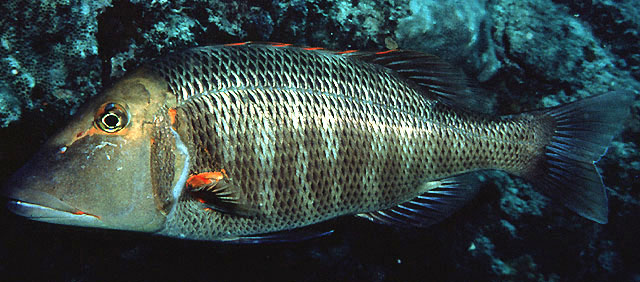| Lethrinidae (Emperors or scavengers), subfamily: Lethrininae |
| 90 cm TL (male/unsexed); max.weight: 9,600.0 g; max. reported age: 22 years |
|
reef-associated; brackish; marine; depth range 5 - 30 m, non-migratory |
| Western Pacific: The Ryukyu Islands, eastern Philippines, northern Australia, and New
Caledonia (Ref. 114226). Occurrence records outside distributional range probably refer to Lethrinus olivaceus (Ref. 2295). |
|
Dorsal spines (total): 10-10; Dorsal soft rays (total): 9-9; Anal spines: 3-3; Anal soft rays: 8-8. This species is distinguished by the following characters: body moderately deep, its depth 2.4-2.8 times in standard length; head length 0.9-1 times in body depth, 2.5-2.9 times in SL, dorsal profile near eye slightly convex; snout moderately long, its length about 1.7-2.4 times in HL, measured without the lip the snout is 0.9-1 times in cheek height, its dorsal profile slightly concave, snout angle relative to upper jaw between 50° and 65°; interorbital space convex to flat; posterior nostril an oblong longitudinal opening, closer to orbit than anterior nostril; eye situated close to dorsal profile, its length 3.4-5.4 times in HL; cheek moderately high, its height 2.0-2.9 times in HL; lateral teeth in jaws conical; outer surface of maxilla smooth or with a longitudinal ridge; D X,9 with the 3rd dorsal-fin spine usually longest, its length 2.3-2.9 times in body depth; A III,8 with the 1st or 2nd soft ray usually the longest, its length almost equal to or slightly longer than length of base of soft-rayed portion of anal fin and 1.3-1.4 times in length of entire anal-fin base; pectoral-fin rays 13; pelvic-fin membranes between rays closest to body usually with dense melanophores; no scales on cheek; 46-48 lateral-line scales; 4½ scale rows between lateral line and base of middle dorsal-fin spines; 15 to 17 scale rows in transverse series between origin of anal fin and lateral line; usually 15 rows in lower series of scales around caudal peduncle; 2-7 scales in supratemporal patch; inner surface of pectoral fins partially or densely covered with scales; posterior angle of operculum fully scaly. Colour of body silvery, tan, or yellowish, base of scales often black, often a series of 8-9 dark bars (may be absent in some individuals); base of pectoral fins red; sometimes a red streak originating on upper operculum, passing beneath eye and onto snout; 2 red spots often on upper rim of eye; lips reddish; fins pale or reddish, sometimes brilliant red on membranes near base of pelvic fins, and between spinous rays of dorsal and anal fin (Ref 68703). |
| Adults inhabit coral reefs during daytime where they feed occasionally in sand and rubble areas between coral heads. At night, they move out over the sandy sea floor and forage actively. Usually occur in small schools. Juveniles live in shallow, inshore waters such as seagrass and mangrove areas, moving into deeper water as they age (Ref. 27260, 28202). Feed mainly on crustaceans, echinoderms, mollusks and fish, with crabs and sea urchins predominating. Much of the information reported for this species was based on misidentifications and referred to L. olivaceous (see Ref. 2295). Marketed fresh or frozen (Ref. 9987). Caught primarily by handline. One of the favourite food and sport fishes around the Great Barrier Reef. A major food fish in New Caledonia. Occasionally implicated in cases of fish poisoning (ciguatoxin) (Ref. 68703). |
|
Least Concern (LC); Date assessed: 09 March 2015 Ref. (130435)
|
| reports of ciguatera poisoning |
Source and more info: www.fishbase.org. For personal, classroom, and other internal use only. Not for publication.
